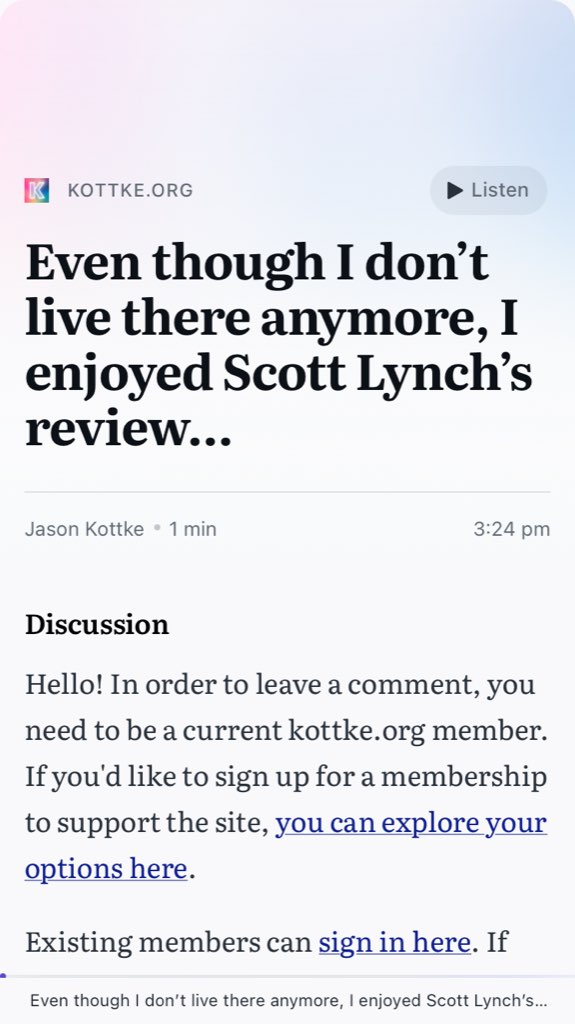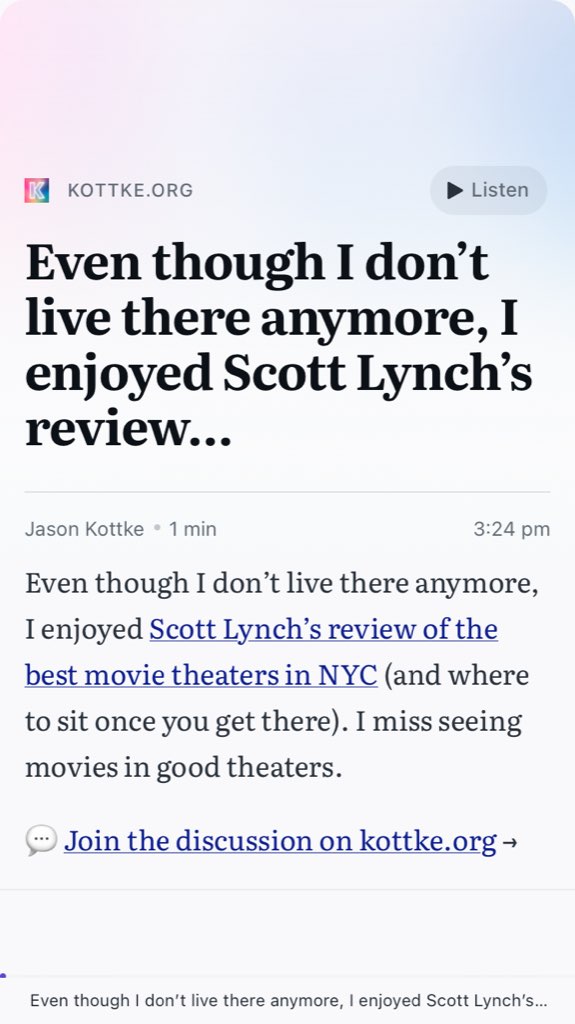A few years ago James A. Reeves threw sunshine on Prince Edward Island, and on Clark and me:
Today I noticed two of my favorite blogs come from Prince Edward Island. Over the past few years, Peter Rukavina and Clark MacLeod have become welcome presences in my feed that epitomize a relaxed, more personal internet of yore—and hopefully the future. I have no idea if one referred me to the other or if they even know one another. I also realized I had no idea where Prince Edward Island was, so I looked it up this afternoon. It looks beautiful on the map: a squiggle tucked in the bottom of the Gulf of Saint Lawrence, its arms cocked northeast toward the coast of Newfoundland and the frozen cadence beyond: Labrador Trough. Baffin Bay. Cumberland Sound.
I’d be remiss if I didn’t through sunshine back.
James reappeared in January, after a season’s absence from my feedreader, and I find myself looking forward to every post. He is, at heart, a psychogeographer, and so his writing about place—Why Am I in Ohio?, Mysterium, On a Shrinking Globe in an Expanding Universe—is particularly welcome.
The Funniest, Simplest Game to Play Before Dinner:
So, this week, the boys and I went to dinner with our friend Grace, and while we waited for our food, we played the funniest simple game. As a group, you try to count to 20, and anyone can call out each number, but two people can’t say the number at the same time. So, for example, in our game, Toby said, “one,” and then we all looked around nervously until Anton called out, “two!” and then I quickly said, “three” before anyone else did, and then Grace and Anton said, “four” at the same time, and we had to start over. Make sense?
We do this as a warmup exercise in our improv class, and it can be fascinating: you stumble and wobble forever, then something meshes—perhaps everyone closes their eyes, or breathes together, or moves closer—and, presto, you’re a beautiful synchronized counting machine.
Thelma writes about her parents’ trip to Miami, 60 years ago this month, and how it conflued with world events. A lovely story.
How to buy sustainable salmon: an expert guide to navigating the nuance of eco-labels is a helpful guide.
Smoked salmon on a bagel is a Saturday morning ritual here, after two decades of it being a Saturday morning Charlottetown Farmers’ Market ritual for me and Olivia.
In the transition from farmers’ market salmon to supermarket salmon, though, we went from salmon sourced and smoked by the man who was slicing it to anonymous salmon caught (somehow) in Scotland or Norway and smoked (somehow) in Poland or South Africa.
(via Eat This Newsletter)
I’m posting this here as a service to the stymied. My 1Password, both on mobile and desktop, was complaining about being “offline,” despite my not actually being offline.
The error message on the desktop, accompanied by a red cloud icon in the app’s toolbar with a slash through it, looked like this:

I was confounded.
I uninstalled and reinstalled, checked my network connection, restarted my computer: nothing helped.
With the aid of 1Password support, to which I sent a diagnostics log, I learned that the error was a result of a 1Password Business account to which I no longer had access still being “signed in”:
Thanks for sending that diagnostics report through to me from 1Password on your Mac and apologies for the confusion as to why 1Password is reporting itself as offline here. After taking a look at the report, it looks like you have a suspended 1Password Business account signed in to the app on your Mac which is why 1Password is reporting itself as offline.
Sure enought that was it: I signed out of the offending account, and suddently I was “back online.”
Polly Coles writes, in The Politics of Washing, her memoir of living a year in Venice with her husband and four children, about a vaporetto that carries only residents, not tourists:
But it is not only colour and numbers that distinguish the passengers on the Three; it is a subtle but unmistakable difference of purpose that infuses every pore of the people who use it. Tourists are visibly mystified when the marinaio does not even stop to look at individual passes, and yet suddenly, unaccountably, prevents certain people from getting on to the vaporetto. But to those of us who are hurrying to school, or university, or the market, or work, it is perfectly clear that the man on the right is a tourist, while the man on the left is going to fetch his son from nursery. The marinaio does not need to see their tickets to know that. Why? Because human beings on holiday are radically different from human beings who are negotiating their way through the myriad small hurdles of daily life. It is as if the billions of atoms of which we are made become somehow more compacted when there is a job to be done, so that we exude purpose like a powerful scent - even, somehow, look different.
Holidaymakers inhabit a different skin; they are, above all else, in no hurry. The long day ahead contains no appointments, commitments, decisions or duties; all they have to do is eat and sleep and enjoy themselves as much as they possibly can. In this happy state of no-responsibility the body, so often tensed for action, relaxes. Their aura is unmistakably looser, their pace slower: they amble, pause to admire, hesitate about which direction to take, turn back to pass comment to a companion. They are, in a way, infantilized because they have been relieved of all the pressure to keep up to speed, on track or any of the other heartracing metaphors favoured by Western culture in the world of work.
This is a sentiment that perhaps only people who live in the neighbourhood cum stage set that is a tourist city: who among us has not been stymied on a trip to the post office by a gaggle of visitors, walking four abreast, in this “happy state of no-responsibility.”
Coles’ book is an interesting read, both a tale of a family odyssey and an extended rumination on Venice and the tensions—tensions that exist on an exponentially greater level than here in sedate Charlottetown—between people who live there and people who visit.
This is a very niche post, which I write simply to help others who fall in the niche with me; the rest of you can move right along.
As I’ve mentioned before in passing, my RSS reader of choice these days is Reader, from the team that brought us Readwise (itself an estimable “highlight and catalog what you read” app in its own right).
Reader reads RSS feeds, but it’s also good, in an Instapaper-like way, of parsing HTML: you can use its browser extension to save an article you’re reading, for example, and it will show up in your Reader queue, in a nice distraction-and-advertising-free readable format.
There’s one aspect of Reader that’s mildly annoying: if an RSS feed is reported by another user as having a parsing issue, it can get marked on a system-wide level as “don’t use the RSS feed, but instead try scraping the HTML from the website.” In theory that’s a great and helpful fallback move, but, in practice, in can result a perplexingly presented feed.
Kottke.org is a feed of particular annoyance: if the site’s RSS feed is fed to Reader, then posts appear like this:

The body of the post is missing, and all that’s displayed is verbiage from the post footer about commenting.
I went back and forth with the (excellent) Reader user support desk a few times and that’s how I learned about the “helpful fallback move” that was causing it. Alas, as, again, this flag is set on a system level, it’s outside my control.
I found a fix, though: it seems like Reader tracks this flag using an exact URL match for the feed, so if I attach a random parameter to the RSS feed address, like this:
http://www.kottke.org/index.xml?feed
then this appears to Reader as a different RSS feed, and the workaround isn’t kicked in, so posts appear as you want them to:

I imagine that this kind of thing will be sorted by Reader at some point; in the meantime, this hack is useful.
I am a paying customer of Kagi, decamping from a lifetime of Google as my default search engine. The search results are almost always better than Google’s, especially for the non-commercial web.
Like every other toaster on the planet, Kagi is using AI to deliver what they call ”quick answers” (you can see them by clicking the “quick answer” link in search results, or simply by adding a question mark to the end of your search terms).
The current “quick answer” returned for a search for “Peter Rukavina” shows the downside of the current state of the art in munging together disparate web results and trying to sew a complete story: Kagi gets some of the details right (I am a writer, printer, and developer in Canada, and my blog is indeed here at ruk.ca), but it also reports that I died in 2012 after a setback in hospital (not true). There’s about half of the result that’s “true” (if I’m there Peter Rukavina in questions) and half that’s not.
I’m posting this here, in part, as a place marker to return to as technology advances and this sort of issues gets solved.
![Screen shot of a Kagi search result, showing a "Quick Answer" for the search "Peter Rukavina": Based on the search results, Peter Rukavina seems to be: A writer, printer and developer based in Canada. His personal blog is at ruk.ca[1]. He passed away in September 2012 after a setback in the hospital, leaving behind a 23-year-old autistic trans daughter[2]. At the time of his passing, he was a four-year widower and also the burgeoning stepfather to a 12-year-old daughter[3]. He has written speeches and produced audio work that provide more information about him[1]. He has a LinkedIn profile listing his previous role as President of Rukavina Trade Consultants Inc.[4]. As a lifeguard when he was younger, he was described as the captain everyone wanted to follow[5].](/sites/ruk.ca/files/kagiquick.jpg)
Through his weekly People and Blogs newsletter, Manuel Moreale is emerging as a sort of “Aslan of the small web.”
With Phil Gyford, whose ooh.directory is an old-style-Yahoo! directory of “blogs about every topic,” Kagi’s Small Web search, and Marginalia’s search, the personal, non-commercial, passionate part of the web—what you might call “the old web,” or “the web before capitalism blotted out the sun”—is re-emerging from under the bushel basket that Google’s search algorithm has imposed on it in recent years.
(Here’s a fun way to spend an afternoon: enter a word, any old word, into a Kagi search, and flip the “Small Web” toggle. I guarantee you will find interesting things: here’s a recipe for Brussels Sprout Fried Rice and here’s a post about walking through Bulgaria, for example.)
Which is all a circuitous way of announcing that I’m proud to be included in People and Blogs myself this week. I enjoyed the process of answering Manuel’s questions about my blog and my blogging, and the chance to remind myself why and how much I have loved—do love—this space.

 I am
I am